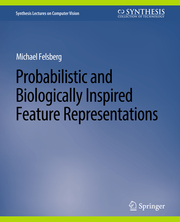Detailansicht
Probabilistic and Biologically Inspired Feature Representations
Synthesis Lectures on Computer Vision
ISBN/EAN: 9783031006944
Umbreit-Nr.: 5884505
Sprache:
Englisch
Umfang: xiii, 89 S.
Format in cm:
Einband:
kartoniertes Buch
Erschienen am 29.05.2018
Auflage: 1/2018
- Zusatztext
- Under the title "Probabilistic and Biologically Inspired Feature Representations," this text collects a substantial amount of work on the topic of channel representations. Channel representations are a biologically motivated, wavelet-like approach to visual feature descriptors: they are local and compact, they form a computational framework, and the represented information can be reconstructed. The first property is shared with many histogram- and signature-based descriptors, the latter property with the related concept of population codes. In their unique combination of properties, channel representations become a visual Swiss army knife-they can be used for image enhancement, visual object tracking, as 2D and 3D descriptors, and for pose estimation. In the chapters of this text, the framework of channel representations will be introduced and its attributes will be elaborated, as well as further insight into its probabilistic modeling and algorithmic implementation will be given. Channel representations are a useful toolbox to represent visual information for machine learning, as they establish a generic way to compute popular descriptors such as HOG, SIFT, and SHOT. Even in an age of deep learning, they provide a good compromise between hand-designed descriptors and a-priori structureless feature spaces as seen in the layers of deep networks.
- Autorenportrait
- Michael Felsberg received the Ph.D. in engineering from the University of Kiel, Germany, in 2002. Since 2008, he has been a Full Professor and the Head of the Computer Vision Laboratory at Linkoping University, Sweden. His current research interests include signal processing methods for image analysis, computer and robot vision, and machine learning. He has published more than 150 reviewed conference papers, journal articles, and book contributions. He was a recipient of awards from the German Pattern Recognition Society in 2000, 2004, and 2005, from the Swedish Society for Automated Image Analysis in 2007 and 2010, from the Conference on Information Fusion in 2011 (Honorable Mention), from the CVPR Workshop on Mobile Vision 2014, and from the ICPR 2016 track on Computer Vision (Best Paper). He has achieved top ranks on various challenges (VOT: 3rd 2013, 1st 2014, 2nd 2015, 1st 2016, 1st 2017 (sequestered test); VOT-TIR: 1st 2015, 1st 2016, 3rd 2017; OpenCV Tracking: 1st 2015; KITTI Stereo Odometry: 1st 2015, March). He has coordinated the EU projects COSPAL and DIPLECS and has been an Associate Editor of the Journal of Mathematical Imaging and Vision and the Journal of Image and Vision Computing. He was Publication Chair of the International Conference on Pattern Recognition 2014 and served as Track Chair in 2016, has been a VOT-committee member since 2015, was the General Co-Chair of the DAGM symposium in 2011 and General Chair of CAIP 2017,and will be Area Chair at ECCV 2018 and Program Chair of SCIA 2019.
